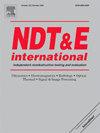基于太赫兹时域光谱技术和图像融合的橡胶夹杂物缺陷检测研究
IF 4.1
2区 材料科学
Q1 MATERIALS SCIENCE, CHARACTERIZATION & TESTING
引用次数: 0
摘要
本文章由计算机程序翻译,如有差异,请以英文原文为准。

Research on rubber inclusion defect detection based on terahertz time-domain spectroscopy technology and image fusion
Rubber, in the process of production and service, may contain foreign objects, such as fragments and films. These inclusions can lead to increased wear of rubber products during actual use, resulting in unpredictable safety risks. Therefore, it is essential to perform non-destructive testing to ensure the quality of rubber products. In this paper, a high-precision and non-destructive detection method for rubber inclusion defects based on terahertz technology is proposed. The terahertz time-domain spectroscopy was used to detect prefabricated Silicone Rubber samples with metallic inclusion defects. The obtained terahertz spectral data are optimized by using correction processing algorithms and feature extraction methods. And a highly efficient quantitative detection model for internal inclusion defects in Silicone Rubber is established using machine learning algorithms. Firstly, SNV, AirPLS, AsLS and BEADS are individually applied to preprocess the collected time-domain spectra. Secondly, the features of the spectra are extracted by using CARS, UVE and PCA, respectively. Lastly, Partial Least Squares Regression and Least Squares Support Vector Machines are employed to establish quantitative prediction model of the depth of rubber inclusion defects. The experimental results show that the BEADS and CARS algorithms can greatly reduces the computational load of the model while improving its accuracy. The LS-SVM model has the best prediction effect, and the RMSEP and RP of the prediction set are 0.0717 and 0.9964, respectively. In addition, the physics-based model of time-of-flight is also employed to calculate the collected time-domain spectra and predict the defect depth, and the RMSEP and RP of the prediction set are 0.1080 and 0.9986. In terms of terahertz imaging, this paper proposes a high-quality visualization processing scheme for internal inclusion defects in rubber. It utilizes various feature parameters for imaging and employs a combination of grayscale histogram equalization and wavelet transform image fusion methods to achieve high-quality imaging representation of internal inclusion defects in rubber. The THz-TDS techniques enables rapid and non-destructive detection of location, depth and shape of rubber inclusion defect, providing new technological methods for the quality inspection of other polymers.
求助全文
通过发布文献求助,成功后即可免费获取论文全文。
去求助
来源期刊

Ndt & E International
工程技术-材料科学:表征与测试
CiteScore
7.20
自引率
9.50%
发文量
121
审稿时长
55 days
期刊介绍:
NDT&E international publishes peer-reviewed results of original research and development in all categories of the fields of nondestructive testing and evaluation including ultrasonics, electromagnetics, radiography, optical and thermal methods. In addition to traditional NDE topics, the emerging technology area of inspection of civil structures and materials is also emphasized. The journal publishes original papers on research and development of new inspection techniques and methods, as well as on novel and innovative applications of established methods. Papers on NDE sensors and their applications both for inspection and process control, as well as papers describing novel NDE systems for structural health monitoring and their performance in industrial settings are also considered. Other regular features include international news, new equipment and a calendar of forthcoming worldwide meetings. This journal is listed in Current Contents.
 求助内容:
求助内容: 应助结果提醒方式:
应助结果提醒方式:


